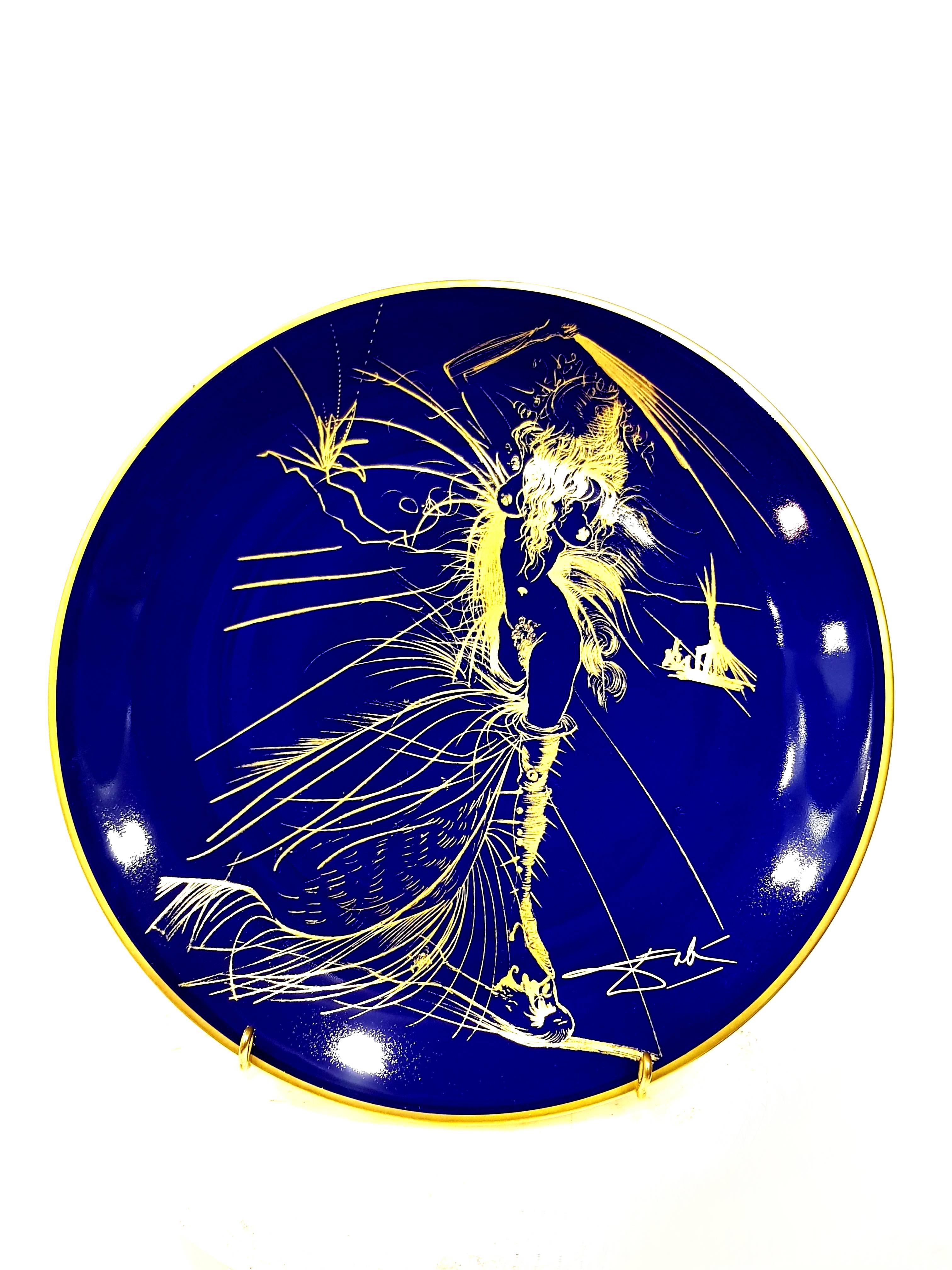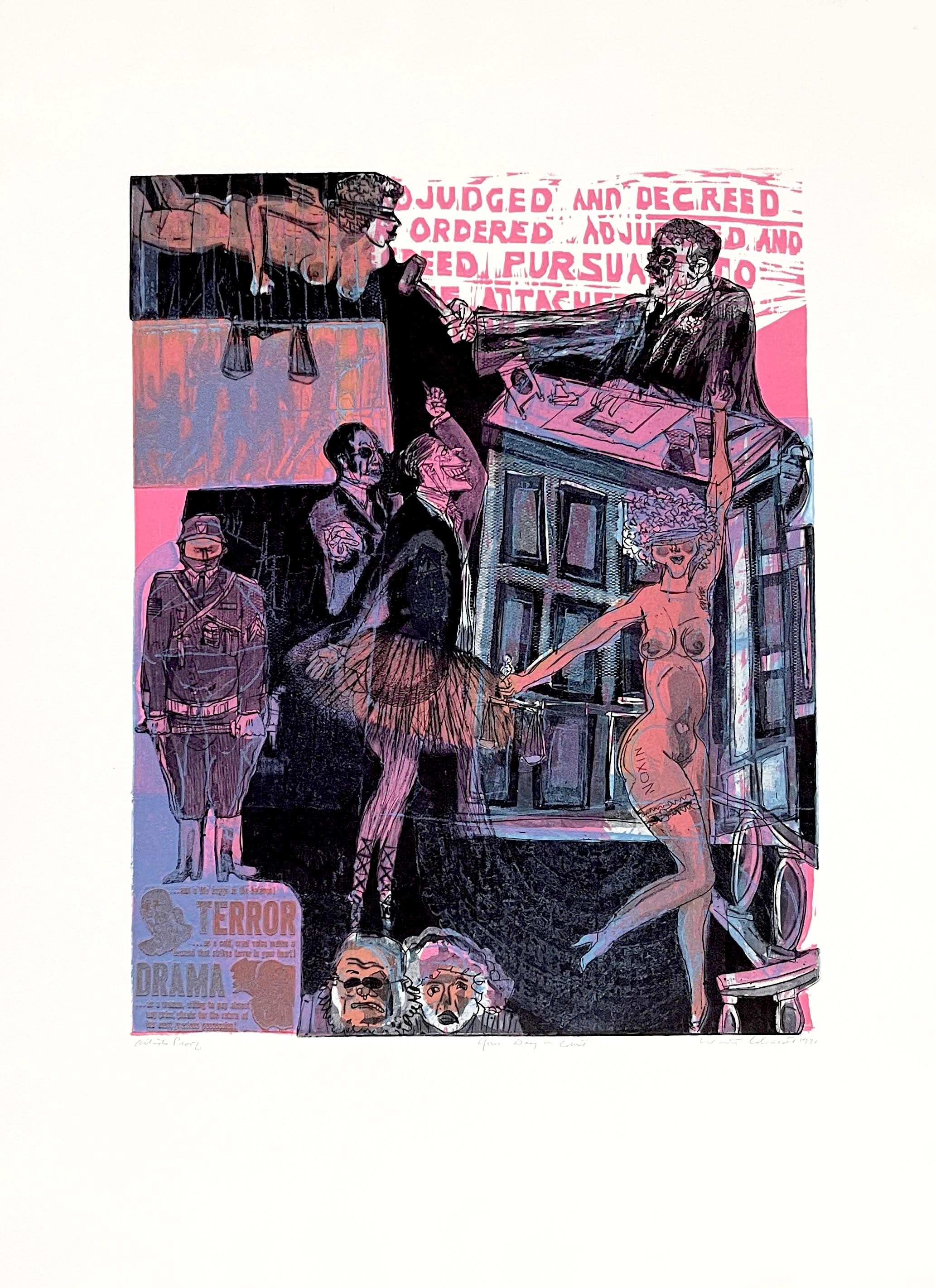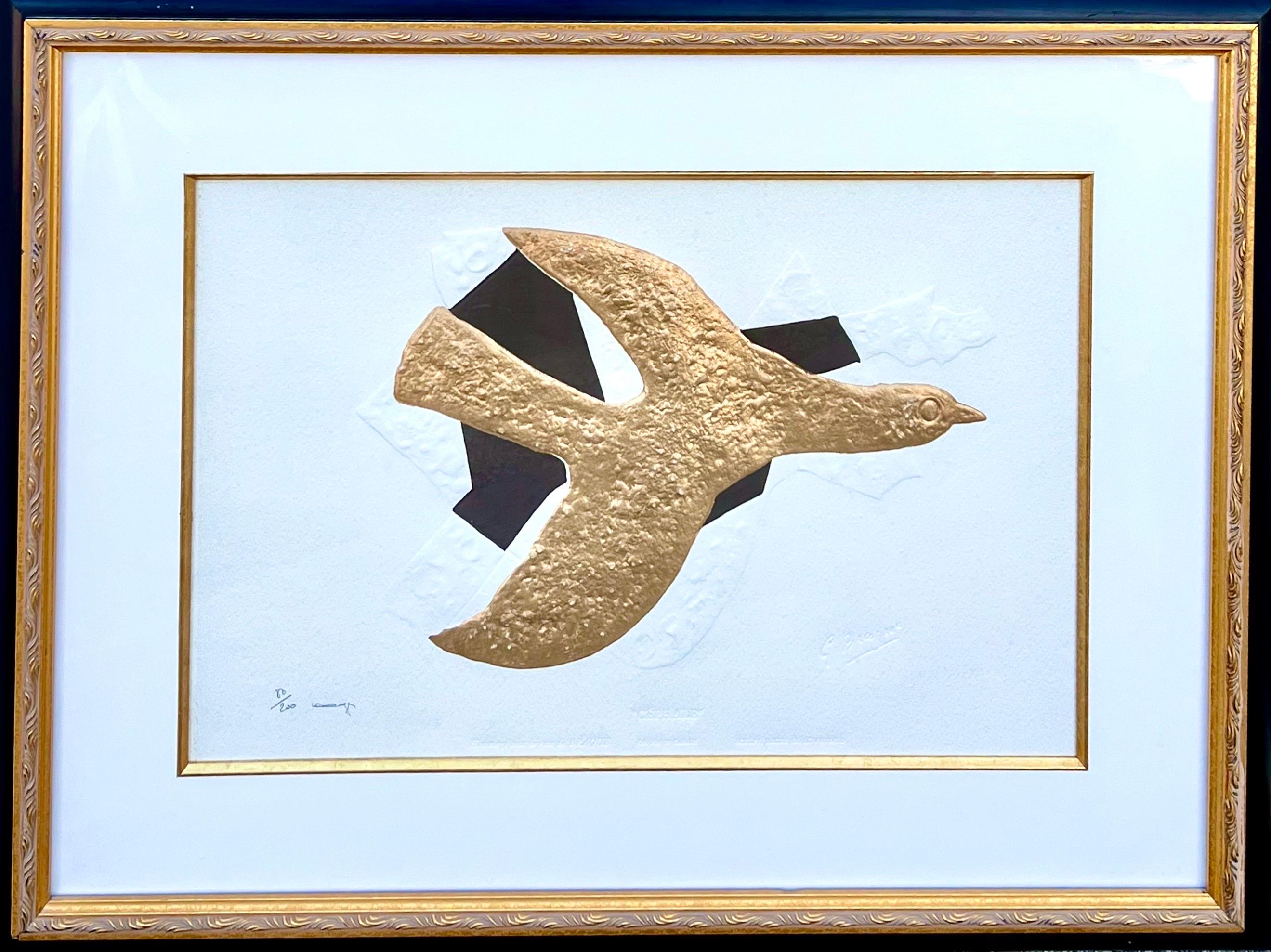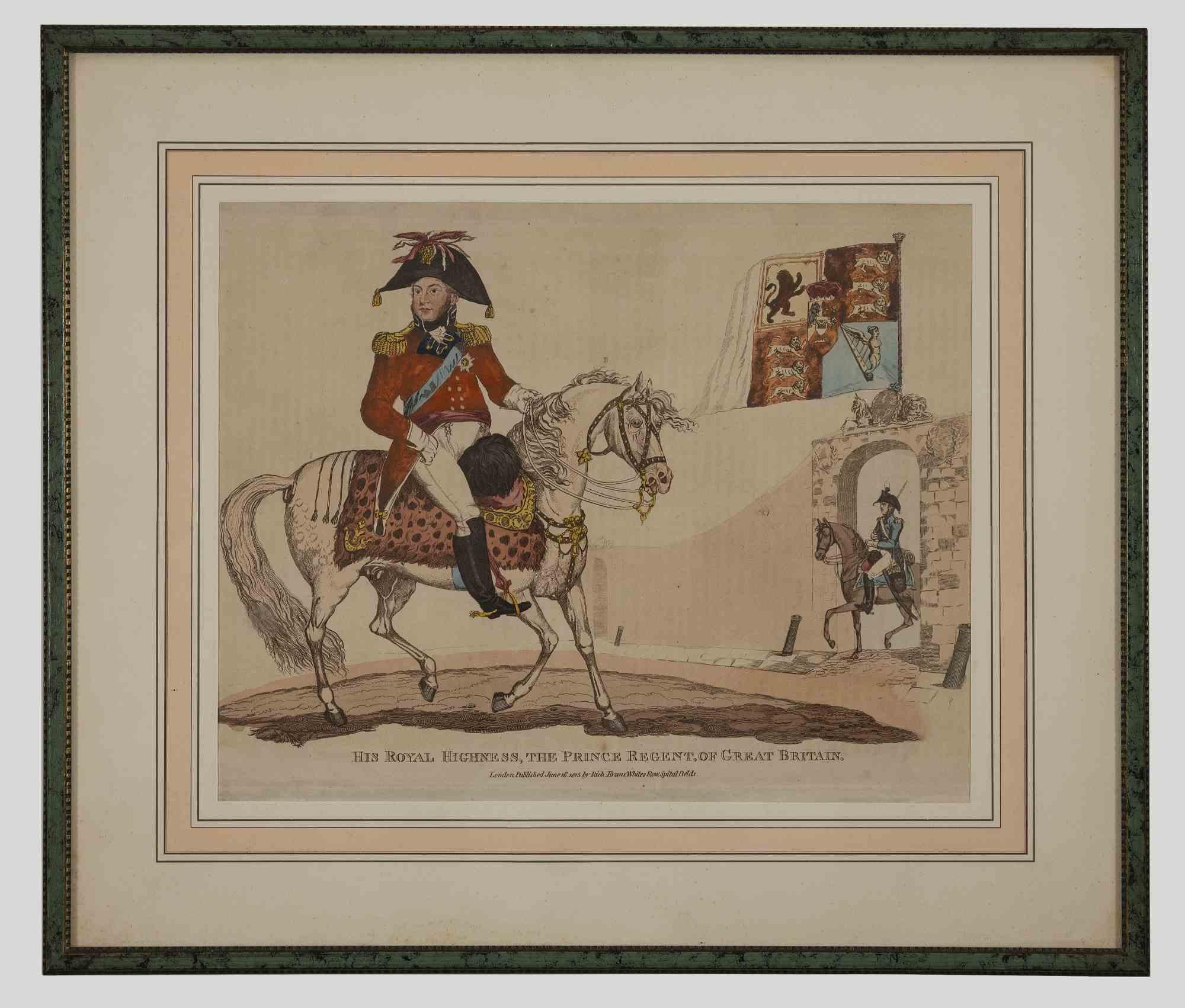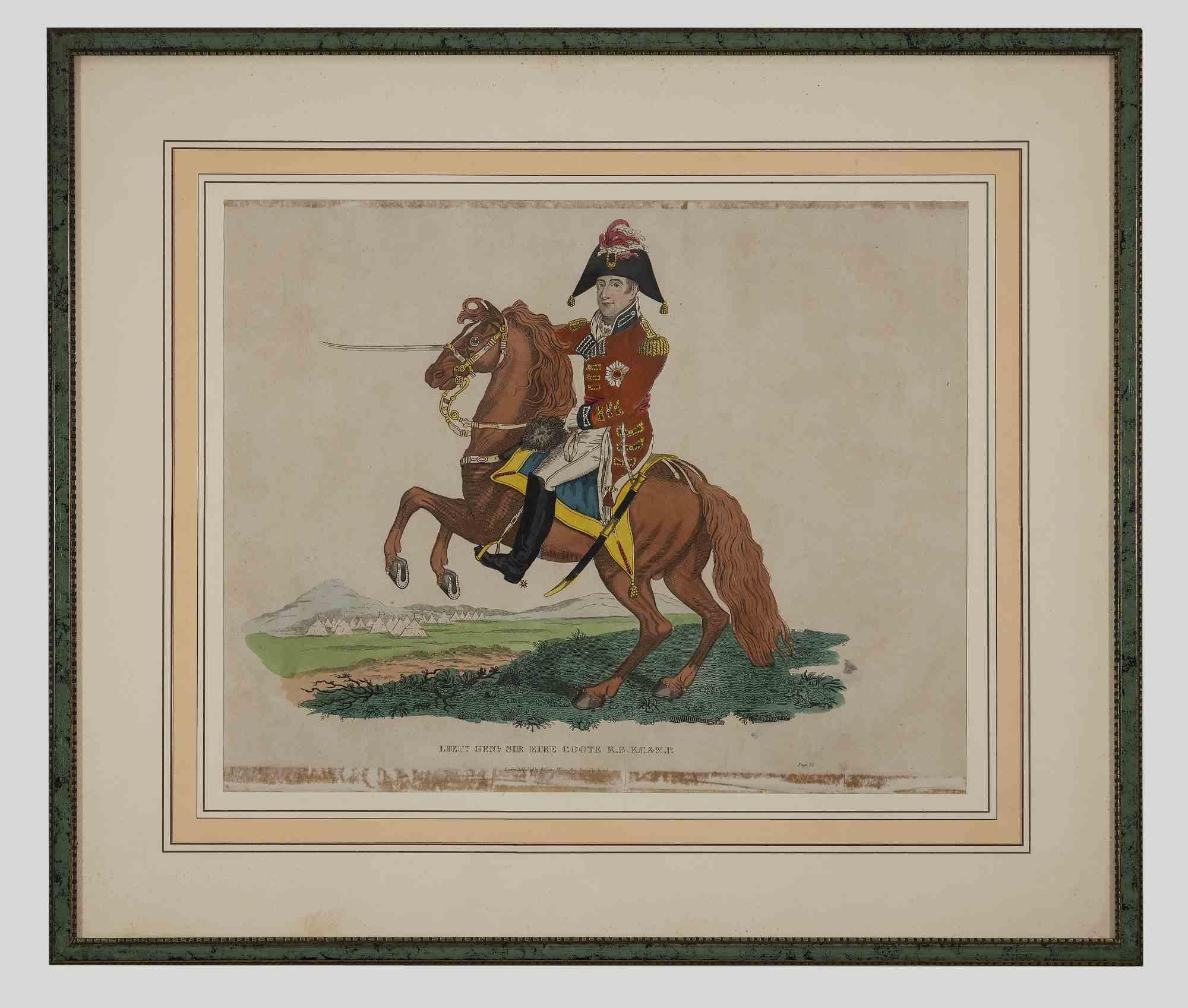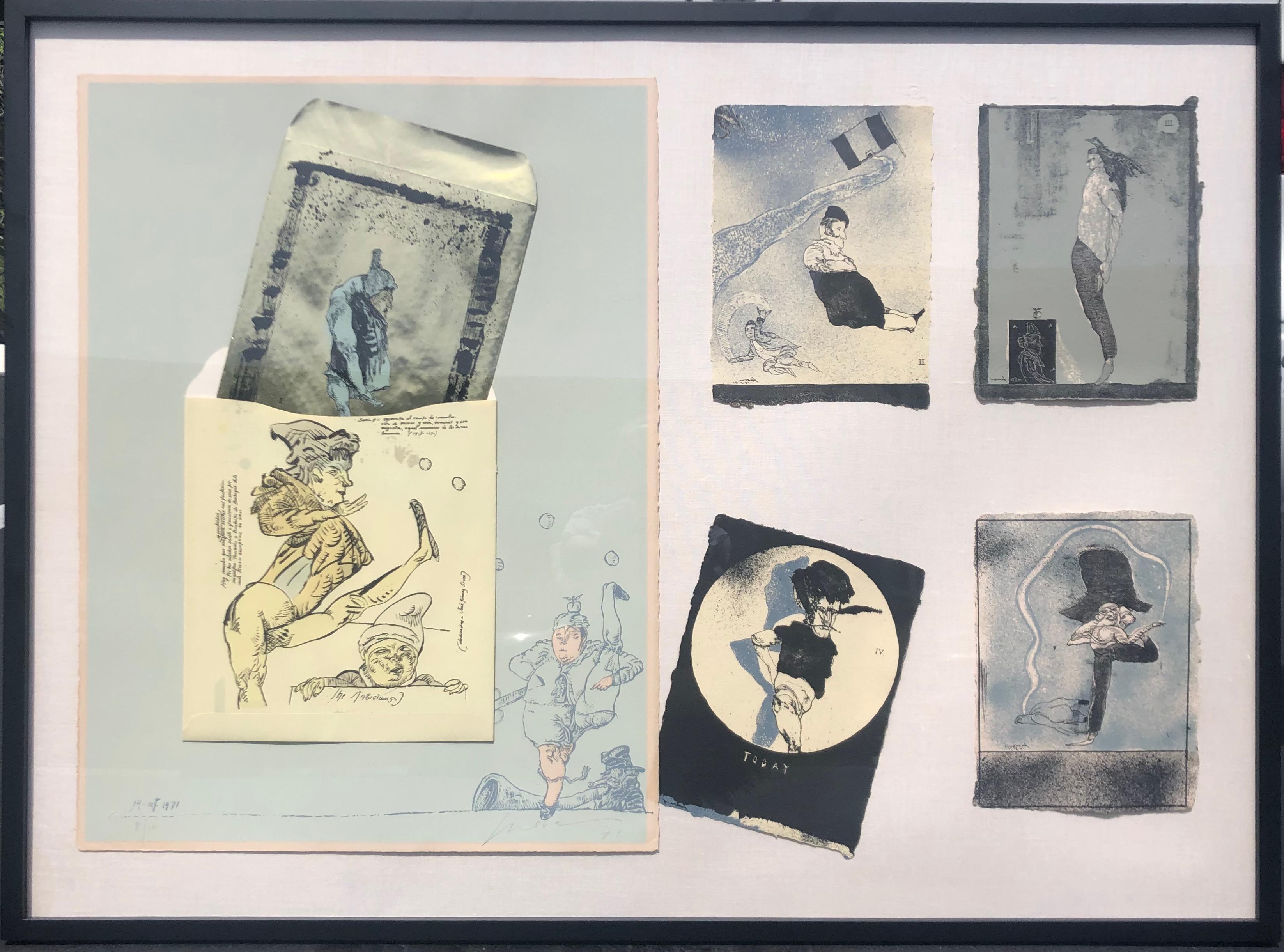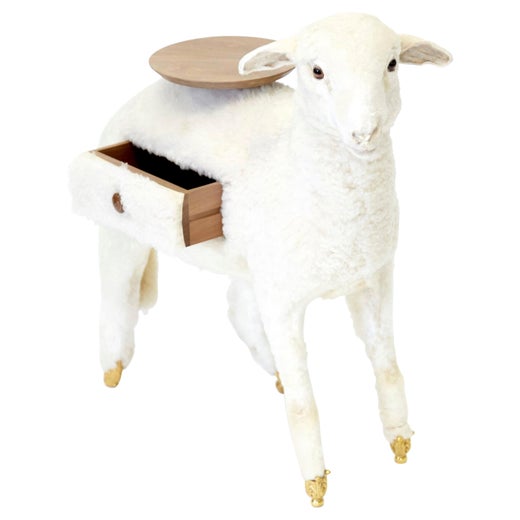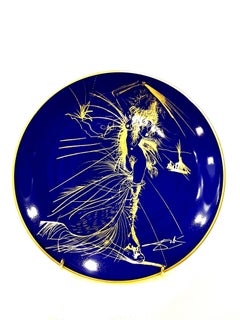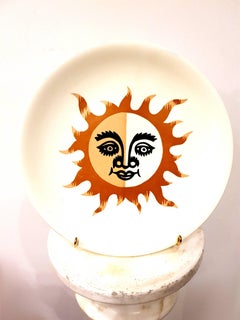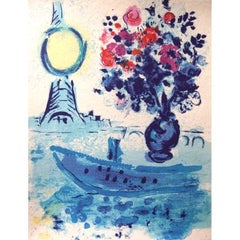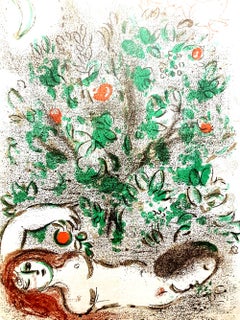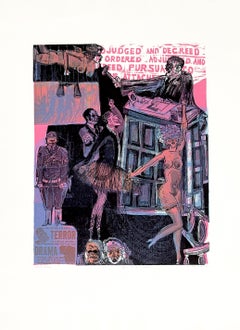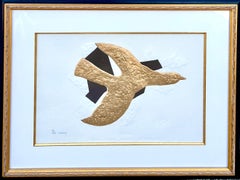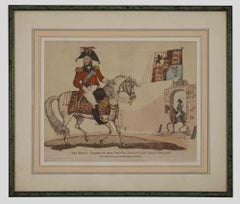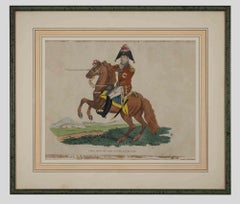Items Similar to Faust - Limoges Porcelain Blue and Gold
Want more images or videos?
Request additional images or videos from the seller
1 of 9
(after) Salvador DaliFaust - Limoges Porcelain Blue and Gold1968
1968
About the Item
Limoges porcelain in "Bleu de Sèvres" and gold.
Artist: Salvador Dali
Exclusive limited edition to 2000 copies "Raynaud & Co. Limoges", France, 1968.
"Faust" drawn by Salvador Dalí. Print signed.
Plate Signed in the back of the plate
Dimensions: Diameter: 26 cm
Edited by Salins Earthenware
Sold in its original box
The company "Raynaud-Limoges" specialized in the production of porcelain products in small runs, among the company's customers - crowned people and representatives of the old aristocratic families of Europe.
Dali - the Prodigy Child without an Exam.
Salvador Dali was born as the son of a prestigious notary in the small town of Figueras in Northern Spain. His talent as an artist showed at an early age and Salvador Felipe Jacinto Dali received his first drawing lessons when he was ten years old. His art teachers were a then well known Spanish impressionist painter, Ramon Pichot and later an art professor at the Municipal Drawing School. In 1923 his father bought his son his first printing press.
Dali began to study art at the Royal Academy of Art in Madrid. He was expelled twice and never took the final examinations. His opinion was that he was more qualified than those who should have examined him.
In 1928 Dali went to Paris where he met the Spanish painters Pablo Picasso and Joan Miro. He established himself as the principal figure of a group of surrealist artists grouped around Andre Breton, who was something like the theoretical "schoolmaster" of surrealism. Years later Breton turned away from Dali accusing him of support of fascism, excessive self-presentation and financial greediness.
By 1929 Dali had found his personal style that should make him famous the world of the unconscious that is recalled during our dreams. The surrealist theory is based on the theories of the psychologist Dr. Sigmund Freud. Recurring images of burning giraffes and melting watches became the artist's surrealist trademarks. His great craftsmanship allowed him to execute his paintings in a nearly photo-realistic style. No wonder that the artist was a great admirer of the Italian Renaissance painter Raphael.
Salvador Dali and Gala.
Meeting Gala was the most important event in the artist's life and decisive for his future career. She was a Russian immigrant and ten years older than Dali. When he met her, she was married to Paul Eluard.
Gala decided to stay with Dali. She became his companion, his muse, his sexual partner, his model in numerous art works and his business manager. For him she was everything. Most of all Gala was a stabilizing factor in his life. And she managed his success in the 1930s with exhibitions in Europe and the United States.
Gala was legally divorced from her husband in 1932. In 1934 Dali and Gala were married in a civil ceremony in Paris and in 1958 in church after Gala's former husband had died in 1952. However from around 1965 on, the couple was seen less frequently together. But Gala continued to manage Dali's business affairs.
1933 Salvador Dali had his first one-man show in New York. One year later he visited the U.S. for the first time supported by a loan of US$500 from Pablo Picasso. To evade World War II, Dali chose the U.S.A. as his permanent residence in 1940. He had a series of spectacular exhibitions, among others a great retrospective at the Museum of Modern Art in New York.
Besides creating a number of great paintings, Dali caused the attention of the media by playing the role of a surrealist clown. He made a lot of money and was contemptuously nicknamed Avida Dollars (greedy for dollars) by Andre Breton.
Dali became the darling of the American High Society. Celebrities like Jack Warner or Helena Rubinstein gave him commissions for portraits. His art works became a popular trademark and besides painting he pursued other activities - jewelry and clothing designs for Coco Chanel or film making with Alfred Hitchcock.
The Classic Period After World War II
In 1948 Dali and Gala returned to Europe, spending most of their time either in their residence in Lligat or Spain or in Paris or France or in New York. Dali developed a lively interest in science, religion and history. He integrated things into his art that he had picked up from popular science magazines.
Another source of inspiration were the great classical masters of painting like Raphael, Velasquez or the French painter Ingres. The artist commented his shift in style with the words: "To be a surrealist forever is like spending your life painting nothing but eyes and noses."
In 1958 the artist began his series of large sized history paintings. He painted one monumental painting every year during the summer months in Lligat. The most famous one, The Discovery of America by Christopher Columbus, can be seen at the Dali Museum in St. Petersburg in Florida. It is breath-taking. The artist's late art works combine more than ever his perfect and meticulous painting technique with his fantastic and limitless imaginations.
Salvador Dali is the only known artist who had two museums dedicated exclusively to his works at lifetime.
Dali Museum in St. Petersburg, Florida
The Dali Museum in St. Petersburg in Florida or U.S.A. was founded in 1971 by the Dali collector A. Reynolds Morse and his wife Eleanor. The collection was first exhibited in a building adjacent to their home in Cleveland/Ohio.
In 1982, the museum was moved to St. Petersburg in Florida. It hosts 95 oil paintings including six of Dali's eighteen large-sized historical paintings.
Dali Museum-Theater in Figueres, Spain.
The Dali Museum-Theater in Figueres, Spain was the former Municipal Theater of Figueres. In 1918, when Salvador Dali was only fourteen years old, it had shown his first public exhibition.
Since 1970 the artist had dedicated his energy to transform the former Municipal Theater into a museum and art gallery. In 1974 the Theatro Museo Dali was officially opened.
1980 Dali was forced to retire due to palsy, a motor disorder, that caused a permanent trembling and weakness of his hands. He was not able to hold a brush any more. The fact that he could not follow his vocation and passion of painting and the news of Gala's death in 1982 left him with deep depressions.
After Gala's death he moved to Pubol, a castle, he had bought and decorated for Gala. In 1984, when he was lying in bed, a fire broke out and he suffered sever burns. Two years later, a pacemaker had to be implanted.
Towards the end of his life, Dali lived in the tower of his own museum where he died on January 23, 1989 from heart failure.
- Creator:(after) Salvador Dali (1904 - 1989, Spanish)
- Creation Year:1968
- Dimensions:Height: 0.79 in (2 cm)Width: 10.24 in (26 cm)Depth: 10.24 in (26 cm)
- Medium:
- Movement & Style:
- Period:
- Condition:
- Gallery Location:Collonge Bellerive, Geneve, CH
- Reference Number:1stDibs: LU16122565501
(after) Salvador Dali
Salvador Dali (1904 – 1989) was a Spanish surrealist artist renowned for his technical skill, precise draftsmanship and the striking and bizarre images in his work. Born in Figueres, Catalonia, Dali received his formal education in fine arts in Madrid. Influenced by Impressionism and the Renaissance masters from a young age, he became increasingly attracted to Cubism and avant-garde movements. He moved closer to Surrealism in the late 1920s and joined the Surrealist group in 1929, soon becoming one of its leading exponents. His best-known work, The Persistence of Memory, was completed in August 1931, and is one of the most famous Surrealist paintings. Dali lived in France throughout the Spanish Civil War (1936 to 1939) before leaving for the United States in 1940 where he achieved commercial success. He returned to Spain in 1948 where he developed his "nuclear mysticism" style, based on his interest in classicism, mysticism and recent scientific developments. Dali's artistic repertoire included painting, graphic arts, film, sculpture, design and photography, at times in collaboration with other artists. He also wrote fiction, poetry, autobiography, essays and criticism. Major themes in his work include dreams, the subconscious, sexuality, religion, science and his closest personal relationships. Some trends in Dali's work that would continue throughout his life were already evident in the 1920s. Dali was influenced by many styles of art, ranging from the most academically classic, to the most cutting-edge avant-garde. His classical influences included Raphael, Bronzino, Francisco de Zurbaran, Vermeer and Velazquez. Exhibitions of his works attracted much attention and a mixture of praise and puzzled debate from critic
About the Seller
4.9
Gold Seller
Premium sellers maintaining a 4.3+ rating and 24-hour response times
Established in 2015
1stDibs seller since 2015
953 sales on 1stDibs
Typical response time: <1 hour
- ShippingRetrieving quote...Shipping from: Collonge Bellerive, Geneve, Switzerland
- Return Policy
Authenticity Guarantee
In the unlikely event there’s an issue with an item’s authenticity, contact us within 1 year for a full refund. DetailsMoney-Back Guarantee
If your item is not as described, is damaged in transit, or does not arrive, contact us within 7 days for a full refund. Details24-Hour Cancellation
You have a 24-hour grace period in which to reconsider your purchase, with no questions asked.Vetted Professional Sellers
Our world-class sellers must adhere to strict standards for service and quality, maintaining the integrity of our listings.Price-Match Guarantee
If you find that a seller listed the same item for a lower price elsewhere, we’ll match it.Trusted Global Delivery
Our best-in-class carrier network provides specialized shipping options worldwide, including custom delivery.More From This Seller
View AllVenus - Limoges Porcelain Blue and Gold
By (after) Salvador Dali
Located in Collonge Bellerive, Geneve, CH
Limoges porcelain in "Bleu de Sèvres" and gold.
Artist: Salvador Dali
Exclusive limited edition to 2000 copies "Raynaud & Co. Limoges", France, 1968.
"Silhouette de Faust" drawn by...
Category
1960s Modern Mixed Media
Materials
Porcelain
Jean Picart Le Doux - Sunshine - Original Salins Earthenware
By Jean Picart Le Doux
Located in Collonge Bellerive, Geneve, CH
Original Salins Earthenware Plate
Artist: Jean Picart Le Doux
Title: Sunshine
Signed in the back of the plate
Dimensions: Diameter: 24 cm
Edited by Salins Earthenware
Jean Picart le Doux, French (1902 - 1982)
Jean Picart Le Doux, born in Paris January 31, 1902 and died in 1982, was a French painter and painter-cartonnier the revival of contemporary tapestry.
He is the son of the painter Charles Picart Le Doux (1881-1959).
Without specialized training, he made his debut in bookbinding and publishing, and then he turned to advertising and graphic arts and publishing his first works in 1935. His first tapestry dating from 1943 after winning the Grand Prix of the theater poster exhibition in the imaging.
He met Jean Lurçat and, with Marc Saint-Saëns, gather around him in 1947 for the Association of painters cardboard tapestry.
In 1950, he projects the idea of the Alliance Graphique Internationale, during the meeting with exhibitors of an exhibition of their work in Basel, two other French designers Jean Jacques Colin and Nathan, and two graphic designers Swiss, Fritz Buhler and Donald Brown...
Category
1960s Modern Mixed Media
Marc Chagall - Bateau Mouche au bouquet - Original Lithograph
By Marc Chagall
Located in Collonge Bellerive, Geneve, CH
Marc Chagall
Original Lithograph
Title: Bateau Mouche au bouquet
1963
Dimensions: 39 x 30 cm
Edition: 180
Unsigned as issued.
From Regards sur Paris
Published by André Sauret
Condit...
Category
1960s Modern Figurative Prints
Materials
Lithograph
Marc Chagall - Paradise - Original Lithograph
By Marc Chagall
Located in Collonge Bellerive, Geneve, CH
Marc Chagall, Original Lithograh depicting an instant of the Bible.
Technique: Original lithograph in colours
On the reverse: another black and white original lithograph
Year: 1960...
Category
1960s Modern Figurative Prints
Materials
Lithograph
Eduardo Arroyo - Jean Moulin - Original Lithograph
By Eduardo Arroyo
Located in Collonge Bellerive, Geneve, CH
Eduardo Arroyo - Jean Moulin - Original Lithograph
1984
Conditions: excellent
Edition: 495
Dimensions: 37,3 x 58 cm
Editions: Trinckvel
Category
1980s Modern Landscape Prints
Materials
Lithograph
$826 Sale Price
20% Off
Pablo Picasso - Painter and His Model - Original Lithograph
By Pablo Picasso
Located in Collonge Bellerive, Geneve, CH
Pablo Picasso - Original Lithograph
Title: Painter and his Model
Edition of 180
From the illustrated book "Regards sur Paris" (Paris: André Sauret, 1962)
Pulled from the folio number...
Category
1960s Modern Portrait Prints
Materials
Lithograph
You May Also Like
Warrington Colescott, Your Day in Court mixed media graphic signed Artists Proof
By Warrington Colescott
Located in New York, NY
Warrington Colescott
Your Day in Court, from the portfolio Wisconsin Graphics, 1971
Drypoint, etching, aquatint, woodcut, & soft-ground etching, w roulette, vibrograver, letterpress ...
Category
1970s Modern Figurative Prints
Materials
Drypoint, Etching, Aquatint, Woodcut
Rare 18 Karat Gold Leaf Embossed Etching After Georges Braque L'Oiseau d'Or
By Georges Braque
Located in Surfside, FL
Embossed print after Braque, based on his sculpture by the same name.
Embossed in the print paper is "'Cephale', Hommage aux bijoux de braque, or fin 23 carat, sculpt heger de Lowen...
Category
20th Century Modern Figurative Prints
Materials
Gold Leaf
The Prince Regent of Great Britain - Original Water-Colored Lithograph - 1816
Located in Roma, IT
The Prince Regent of Great Britain is an original print realized in 1816 ca.
Original mixed colored hand water-colored lithograph.
Title printed on pla...
Category
Early 19th Century Modern Figurative Prints
Materials
Watercolor, Lithograph
$560 Sale Price
24% Off
General Sir Eire Coote - Original Water-colored Lithograph - 1816
Located in Roma, IT
General Sir Eire Coote is an original print realized in 1816 ca.
Original mixed colored hand watercolored lithograph .
Title printed on plate on the lower margin.
Published by Ric...
Category
Early 19th Century Modern Figurative Prints
Materials
Watercolor, Lithograph
$560 Sale Price
24% Off
The Magicians Message From Cuevas' Comedies
By José Luis Cuevas
Located in Lake Worth Beach, FL
The Magicians Message From Cuevas' Comedies.
Screenprint with collage additions and five lithographs from a portfolio
of ten lithographs (one with screenprint and embossing, one with embossing)
and five screenprints (two double-sided, one with collage additions).
Pencil signed and dated 1971, edition 84/100, blindstamp visible, published by Collector's Press, San Francisco.
Framed under Plexiglas.
Jose Louis Cuevas was born in Mexico City in 1933 -2017.
A master draftsman, Jose Luis Cuevas played a pivotal role in Latin America's drawing and printmaking renaissance of the sixties and seventies. He is also associated with Latin America's neofigurative movement, along with artists such as Fernando Botero and Antonio Segui. By the age of fourteen, he had illustrated numerous periodicals and books and had had his first exhibition in Mexico City. In 1953 Cuevas published La cortina del nopal (The Cactus Curtain), an article condemning aspects of the Mexican Mural movement and advocating greater artistic freedom. This philosophy inspired the founding in 1960 of the group Nueva Presencia, which he joined for a brief time. It promoted individual expression and figurative art reflecting the contemporary human condition.
Cuevas' work was influenced by the graphic art of Goya and Picasso as well as by Posada and Orozco, whose representations of deformed creatures, degraded humanity and prostitutes were of particular thematic interest. Over the years, he has paid homage to his favorite painters as well as writers, such as Dostoevsky, Kafka, Quevedo and Sade, in numerous series of drawings and prints. Cuevas has said that his drawing represents the solitude and isolation of contemporary man and man's inability to communicate. It is for this reason that he often distorts and transforms the human figure to the point of uniqueness.
Cuevas has had solo exhibitions in museums and galleries throughout the world including the:
University of Texas, Austin, 1961, the San Francisco Museum of Art, California,1970, the Museo de Arte Moderno, Mexico City, 1972, Museo de Arte Contemporaneo, Caracas, 1974, Phoenix Art Museum, Arizona, 1975, Musee d'Art Moderne, Paris, 1976. His work was included in Four Masters of Line: Jose Luis Cuevas, Alexander Calder, Stuart Davis, and Morris Graves, Musee de la Napoule, France, 1957 and in The Emergent Decade, Cornell University and Solomon R. Guggenheim Museum, New York, 1965. Among his many awards are First International Prize for Drawing, Biennial of Sao Paulo, 1959, First Prize, International Black and White Exhibition, Lugano, Switzerland, 1962, First International Prize for Printmaking, Triennial of Graphic Arts, New Delhi, India, 1968, First Prize, III Latin American Print...
Category
1970s Modern Figurative Prints
Materials
Etching, Lithograph
Alexander Emperor - Original Lithograph - 1816 ca.
Located in Roma, IT
Alexander Emperor is an original print realized in 1816 ca.
Original mixed colored hand watercolor lithograph .
Title printed on plate on the lower margin.
Published by Richard Ev...
Category
Early 19th Century Modern Figurative Prints
Materials
Watercolor, Lithograph
